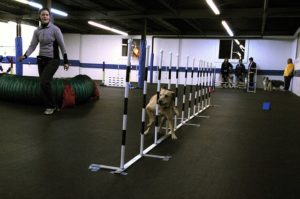
Do you need help dealing with a hyperactive dog?
Is he really hyper, or just climbing the walls because of neglect, boredom, or understimulation? Maybe you have a young dog who’s behaving as young dogs do, you just didn’t adopt the right energy level or age for your lifestyle or interest. Perhaps you have a breed that’s naturally high energy. Does your dog suffer from anxiety, and seems hyper? Can you relate to any of the above?
While hyperactivity does exist (called hyperkinesis), it isn’t usually the cause. Never hurts to have him checked by a vet though, just to be sure. Videotape him when you think he’s being “hyper,” and bring it with you to your  appointment. It will help your vet better understand what you’re talking about, rather than trying to diagnose from your description.
appointment. It will help your vet better understand what you’re talking about, rather than trying to diagnose from your description.
I know he seems like a handful at the moment, and you leave him in the yard because you can’t cope, but it’s not his fault he’s like that, and nothing will ever change unless you help him.
How to help
Introduce structure into his life. Feed and walk him on a schedule, not just “whenever” someone remembers or has the time.
A quick pee and poop on the lawn, or once around the block is not a walk. Get off the couch and go for at least 30 minutes twice a day, and if your dog really is high energy, you better increase the length of that.
In addition to his walks, play with him – throw a ball or Frisbee in the yard.
Take him to the dog park to satisfy his social needs, and to work off some excess energy.
 Find local agility, tracking, or similar classes in your area.
Find local agility, tracking, or similar classes in your area.
After he’s finished exercising and he’s a little tired, get in a quick training session. He may find it easier to focus when his energy has been drained. Teach him to sit, greet people at the door, whatever needs working on but mix it up, or he’ll get bored and lose interest.
Making him sit will teach focus, and being still. Ask him to sit before putting on a leash, and before he crosses the road. Rewarding him with a favourite treat or toy, teaches him how worthwhile it is for him to listen.
Try short clicker training exercises. Hold a treat in front of him, and every time he focuses on it, click then give it to  him. Each time lower the treat a touch. Don’t forget – short sessions.
him. Each time lower the treat a touch. Don’t forget – short sessions.
Mental stimulation is just as important as physical exercise, so play games like hide and seek, go on a treasure hunt and check out the wide range of interactive and treat toys. My article on the importance of mental stimulation has lots of suggestions for things you can do, without even spending a penny.
It’s tempting to yell at him to stop when he’s jumping all over you, nipping at you, barking at you, but ignore him. If you acknowledge him in any way, whether it’s to pet him, speak to him, or even look at him, you’ve just given him what he wanted and shown him his behaviour gets rewarded.
Speak to your vet about pheromone diffusers, or other natural calming products to help your dog relax until your new structure and routine take hold.
Dealing with a hyperactive dog – conclusion
While dealing with a hyperactive dog can be challenging, it isn’t fair on anyone, to leave things the way they are. You may be surprised at how quickly he starts to improve once you provide structure, routine and training.

 Senior Dog Nutrition: Is This The End of Our Confusion?
Senior Dog Nutrition: Is This The End of Our Confusion?
What a great site. I love dogs and have had to deal with many aged dogs. My last two dogs who were brother and sister, died age 17 years! I’ve just listened to your advice about dealing with a hyper dog. This is really good advice and so many people take home a dog that’s not suited to their lifestyle or their own energy level. A good dog can turn into a pain in the neck just because he’s not exercised enough or isn’t challenged mentally and physically. A dog is a huge commitment and so many are found to be unsuitable and end up in the dog home, hopefully to be re-homed with a more suitable owner. Thanks so much for this site, I will look out for you other posts. Ches
Hi Ches, 17 – amazing, you certainly did a great job caring for them. I agree with every word, and wish more people were aware of this. The saddest thing is, the dog is the one who ends up suffering, and more often than not, killed in a shelter because of the kill mentally that goes on in so many shelters around the world. I’m on a mission to try and educate and raise awareness.
Good on you Hindy, I’m not sure where you reside but in the UK the kill rate for dogs is quite low. The Dogs Trust never put a healthy dog to sleep and I think most of the dog homes in the UK follow this ethos if they can. Even so, there is a great deal of suffering for these poor animals if they are thrown out of the family home. A way of getting rid of a dog here can be tieing it to the dog home railings or taking it in the car and abandoning it far away from its home or just moving house and leaving the dog behind, often to die of malnutrition. We have a weekly program here by the RSPCA and the suffering some dogs go through is horrendous. The program always ends on a good note though, with these often ‘near to death’ dogs finding new, loving and permanent homes. Ches
Hi Ches, I live in England as well, and please don’t believe everything you read about shelters here not putting down “healthy” dogs. You would then have to ask what they consider to be a “healthy” dog. Perhaps if they are physically healthy, then that is the case. But what about emotionally? What about dogs that are shy or petrified and bite? They would consider that dog a danger, and more than likely kill him. What if they aren’t adjusting well to being in a cage? I can assure you the large rescues here kill animals that can be safely adopted out. Perhaps they needed to be in a foster home, or paid some extra attention to help them cope. I recommend you do some research, what you find may surprise you.
Hey Hindy
Great post And very well done with your video! I’m very impressed 🙂
Glad you mentioned going for walks and playing to help with the energy. A lot of breeds have hyperactivity in there genes and all it takes is a day in the park to work out all out.
Biggest help in my opinion is to find a job for your dog. Dogs naturally want to please and when you give them a purpose, I find with our dogs anyway, that it makes a massive difference.
Keep up the awesome work!
Cheers,
Marc Parsons
Thank you Marc. As clear as I try and be when I write, sometimes a little talking (or in my case a lot) helps. You’re absolutely right about a job. Many were bred to perform specific tasks, so if we help them satisfy what they naturally want/need to do, our dogs will be a lot happier and well adjusted.
Hi Hindy,
This is such a good post with great information.
I think it’s important to educate people about the needs of dogs – mentally and physically. I’ve seen dogs in a deep depression from lack of exercise and mental stimulation.
My 2 young ones Zeze (3) and Lexi (1) need a lot of exercise. They have 45 minutes early morning and 45 minutes late afternoon when the African sun has started setting.
When it’s raining, we have puzzles and other interactive toys to play with. And they love some nose work and hide-and-seek! Enough exercise keeps them satisfied and out of mischief.
Awesome post!
Chat soon,
R
Thanks Rosemary, I couldn’t agree with you more. Sadly too many people I see with dogs have no clue how important it is to provide them with enough physical exercise and mental stimulation. The majority of my neighbours, while lovely people, don’t take good enough care of their dogs. Offering to help doesn’t work, and they certainly don’t want to hear what I have to say. I keep at it though, and one day I won’t be so diplomatic and I’ll explode!! You’re incredible the lengths you go to for your dogs.